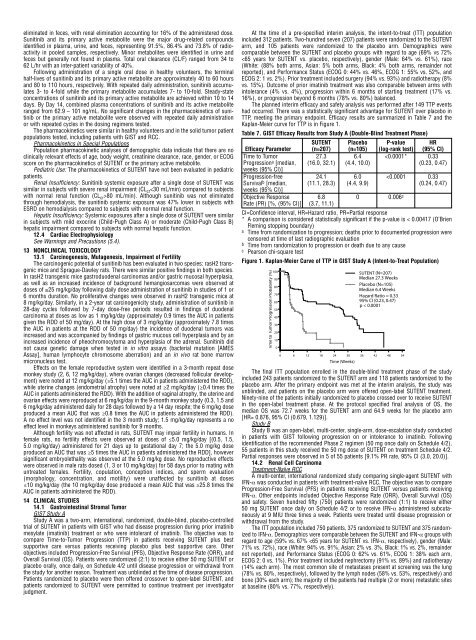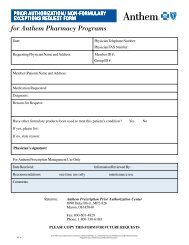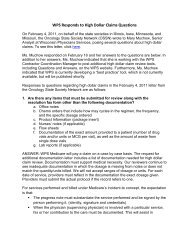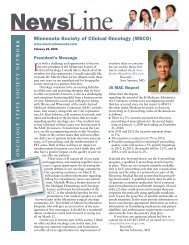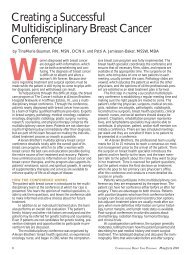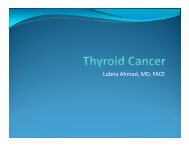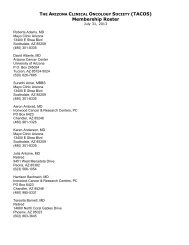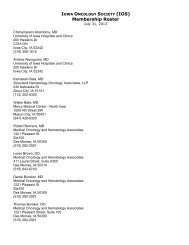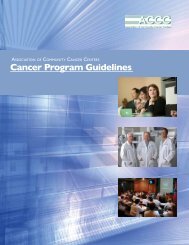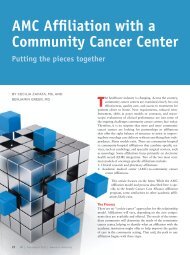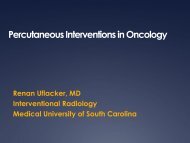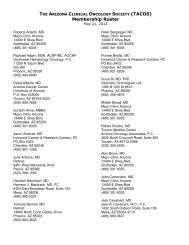2013 Patient Assistance and Reimbursement Guide - Association of ...
2013 Patient Assistance and Reimbursement Guide - Association of ...
2013 Patient Assistance and Reimbursement Guide - Association of ...
You also want an ePaper? Increase the reach of your titles
YUMPU automatically turns print PDFs into web optimized ePapers that Google loves.
eliminated in feces, with renal elimination accounting for 16% <strong>of</strong> the administered dose.<br />
Sunitinib <strong>and</strong> its primary active metabolite were the major drug-related compounds<br />
identified in plasma, urine, <strong>and</strong> feces, representing 91.5%, 86.4% <strong>and</strong> 73.8% <strong>of</strong> radio -<br />
activity in pooled samples, respectively. Minor metabolites were identified in urine <strong>and</strong><br />
feces but generally not found in plasma. Total oral clearance (CL/F) ranged from 34 to<br />
62 L/hr with an inter-patient variability <strong>of</strong> 40%.<br />
Following administration <strong>of</strong> a single oral dose in healthy volunteers, the terminal<br />
half-lives <strong>of</strong> sunitinib <strong>and</strong> its primary active metabolite are approximately 40 to 60 hours<br />
<strong>and</strong> 80 to 110 hours, respectively. With repeated daily administration, sunitinib accumulates<br />
3- to 4-fold while the primary metabolite accumulates 7- to 10-fold. Steady-state<br />
concentrations <strong>of</strong> sunitinib <strong>and</strong> its primary active metabolite are achieved within 10 to 14<br />
days. By Day 14, combined plasma concentrations <strong>of</strong> sunitinib <strong>and</strong> its active metabolite<br />
ranged from 62.9 – 101 ng/mL. No significant changes in the pharmacokinetics <strong>of</strong> sunitinib<br />
or the primary active metabolite were observed with repeated daily administration<br />
or with repeated cycles in the dosing regimens tested.<br />
The pharmacokinetics were similar in healthy volunteers <strong>and</strong> in the solid tumor patient<br />
populations tested, including patients with GIST <strong>and</strong> RCC.<br />
Pharmacokinetics in Special Populations<br />
Population pharmacokinetic analyses <strong>of</strong> demographic data indicate that there are no<br />
clinically relevant effects <strong>of</strong> age, body weight, creatinine clearance, race, gender, or ECOG<br />
score on the pharmacokinetics <strong>of</strong> SUTENT or the primary active metabolite.<br />
Pediatric Use: The pharmacokinetics <strong>of</strong> SUTENT have not been evaluated in pediatric<br />
patients.<br />
Renal Insufficiency: Sunitinib systemic exposure after a single dose <strong>of</strong> SUTENT was<br />
similar in subjects with severe renal impairment (CL cr 80 mL/min). Although sunitinib was not eliminated<br />
through hemodialysis, the sunitinib systemic exposure was 47% lower in subjects with<br />
ESRD on hemodialysis compared to subjects with normal renal function.<br />
Hepatic Insufficiency: Systemic exposures after a single dose <strong>of</strong> SUTENT were similar<br />
in subjects with mild exocrine (Child-Pugh Class A) or moderate (Child-Pugh Class B)<br />
hepatic impairment compared to subjects with normal hepatic function.<br />
12.4 Cardiac Electrophysiology<br />
See Warnings <strong>and</strong> Precautions (5.4).<br />
13 NONCLINICAL TOXICOLOGY<br />
13.1 Carcinogenesis, Mutagenesis, Impairment <strong>of</strong> Fertility<br />
The carcinogenic potential <strong>of</strong> sunitinib has been evaluated in two species: rasH2 transgenic<br />
mice <strong>and</strong> Sprague-Dawley rats. There were similar positive findings in both species.<br />
In rasH2 transgenic mice gastroduodenal carcinomas <strong>and</strong>/or gastric mucosal hyperplasia,<br />
as well as an increased incidence <strong>of</strong> background hemangiosarcomas were observed at<br />
doses <strong>of</strong> ≥25 mg/kg/day following daily dose administration <strong>of</strong> sunitinib in studies <strong>of</strong> 1 or<br />
6 months duration. No proliferative changes were observed in rasH2 transgenic mice at<br />
8 mg/kg/day. Similarly, in a 2-year rat carcinogenicity study, administration <strong>of</strong> sunitinib in<br />
28-day cycles followed by 7-day dose-free periods resulted in findings <strong>of</strong> duodenal<br />
carcinoma at doses as low as 1 mg/kg/day (approximately 0.9 times the AUC in patients<br />
given the RDD <strong>of</strong> 50 mg/day). At the high dose <strong>of</strong> 3 mg/kg/day (approximately 7.8 times<br />
the AUC in patients at the RDD <strong>of</strong> 50 mg/day) the incidence <strong>of</strong> duodenal tumors was<br />
increased <strong>and</strong> was accompanied by findings <strong>of</strong> gastric mucous cell hyperplasia <strong>and</strong> by an<br />
increased incidence <strong>of</strong> pheochromocytoma <strong>and</strong> hyperplasia <strong>of</strong> the adrenal. Sunitinib did<br />
not cause genetic damage when tested in in vitro assays (bacterial mutation [AMES<br />
Assay], human lymphocyte chromosome aberration) <strong>and</strong> an in vivo rat bone marrow<br />
micronucleus test.<br />
Effects on the female reproductive system were identified in a 3-month repeat dose<br />
monkey study (2, 6, 12 mg/kg/day), where ovarian changes (decreased follicular development)<br />
were noted at 12 mg/kg/day (≥5.1 times the AUC in patients administered the RDD),<br />
while uterine changes (endometrial atrophy) were noted at ≥2 mg/kg/day (≥0.4 times the<br />
AUC in patients administered the RDD). With the addition <strong>of</strong> vaginal atrophy, the uterine <strong>and</strong><br />
ovarian effects were reproduced at 6 mg/kg/day in the 9-month monkey study (0.3, 1.5 <strong>and</strong><br />
6 mg/kg/day administered daily for 28 days followed by a 14 day respite; the 6 mg/kg dose<br />
produced a mean AUC that was ≥0.8 times the AUC in patients administered the RDD).<br />
A no effect level was not identified in the 3 month study; 1.5 mg/kg/day represents a no<br />
effect level in monkeys administered sunitinib for 9 months.<br />
Although fertility was not affected in rats, SUTENT may impair fertility in humans. In<br />
female rats, no fertility effects were observed at doses <strong>of</strong> ≤5.0 mg/kg/day [(0.5, 1.5,<br />
5.0 mg/kg/day) administered for 21 days up to gestational day 7; the 5.0 mg/kg dose<br />
produced an AUC that was ≥5 times the AUC in patients administered the RDD], however<br />
significant embryolethality was observed at the 5.0 mg/kg dose. No reproductive effects<br />
were observed in male rats dosed (1, 3 or 10 mg/kg/day) for 58 days prior to mating with<br />
untreated females. Fertility, copulation, conception indices, <strong>and</strong> sperm evaluation<br />
(morphology, concentration, <strong>and</strong> motility) were unaffected by sunitinib at doses<br />
≤10 mg/kg/day (the 10 mg/kg/day dose produced a mean AUC that was ≥25.8 times the<br />
AUC in patients administered the RDD).<br />
14 CLINICAL STUDIES<br />
14.1 Gastrointestinal Stromal Tumor<br />
GIST Study A<br />
Study A was a two-arm, international, r<strong>and</strong>omized, double-blind, placebo-controlled<br />
trial <strong>of</strong> SUTENT in patients with GIST who had disease progression during prior imatinib<br />
mesylate (imatinib) treatment or who were intolerant <strong>of</strong> imatinib. The objective was to<br />
compare Time-to-Tumor Progression (TTP) in patients receiving SUTENT plus best<br />
supportive care versus patients receiving placebo plus best supportive care. Other<br />
objectives included Progression-Free Survival (PFS), Objective Response Rate (ORR), <strong>and</strong><br />
Overall Survival (OS). <strong>Patient</strong>s were r<strong>and</strong>omized (2:1) to receive either 50 mg SUTENT or<br />
placebo orally, once daily, on Schedule 4/2 until disease progression or withdrawal from<br />
the study for another reason. Treatment was unblinded at the time <strong>of</strong> disease progression.<br />
<strong>Patient</strong>s r<strong>and</strong>omized to placebo were then <strong>of</strong>fered crossover to open-label SUTENT, <strong>and</strong><br />
patients r<strong>and</strong>omized to SUTENT were permitted to continue treatment per investigator<br />
judgment.<br />
At the time <strong>of</strong> a pre-specified interim analysis, the intent-to-treat (ITT) population<br />
included 312 patients. Two-hundred seven (207) patients were r<strong>and</strong>omized to the SUTENT<br />
arm, <strong>and</strong> 105 patients were r<strong>and</strong>omized to the placebo arm. Demographics were<br />
comparable between the SUTENT <strong>and</strong> placebo groups with regard to age (69% vs 72%<br />


